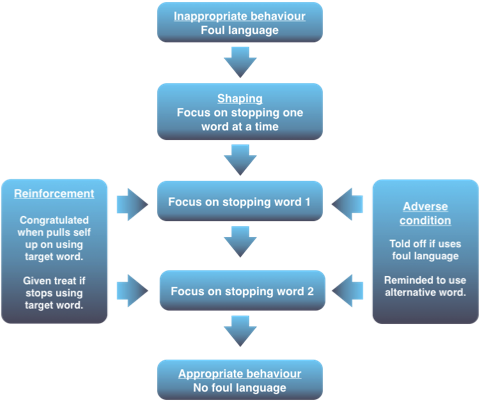Your are at:
- > Home
- > Free stuff
- > Strategies
Ways to encourage appropriate behaviour
In our jargon when you respond to a behaviour that is called a strategy. Discussed in the book are 20 common strategies to use but there are many more. Especially when you start to combine them together. Here are four of our favourites:
Using behaviour agreements
Naming it
Swapping
Shaping
Using behaviour agreements
As discussed on our agreements page, having an agreement in place is a powerful way of establishing an atmosphere where everyone knows what is expected. But how can you use that agreement to bring about change?
(This document is copyright 2012, Murray Irwin. All rights reserved.)
The ‘naming it’ strategy
Sometimes people are simply not aware of their actual behaviour. It is a habit. Naming the behaviour brings it to a conscious level where it can be evaluated. Stating, ‘Calling someone [insert putdown] is disrespectful’, or ‘What I am seeing is people being bullied’, provides feedback. It can be used for providing a reprimand like the examples above or positive reinforcement e.g. ‘That type of behaviour helps show respect.’
Some useful terms when naming are:
- Choosing - That is choosing to be disrespectful
- Going too far - The first time was funny; now it’s going too far
- Fuelling conflict - Continuing to put someone down is fuelling the conflict
- Not OK - Pushing others is not OK
- Disrespectful - I find it disrespectful when people are not listening while I am speaking
- Eroding - Not doing what was agreed upon is eroding trust.
(Adapted from Typo Station’s, ‘Tools for your Toolbox – Introduction to Typo Station Approaches – Supporting all people to take a consistent approach’. Unpublished handbook for family and supporters, circa 2002)
Back to the top
The swapping strategy
Swapping the behaviour is great when a reaction was inappropriate but the reason behind the reaction is justifiable. For example Charlie is not paying attention and runs into Kamari. Kamari’s reaction is to uses foul language and putdowns like calling Charlie 'a stupid idiot'.
It is understandable that Kamari is upset but using foul language and putdowns is not an appropriate solution. Swapping the putdowns with an I-message, Kamari can still express the need for Charlie to be more careful but in a more positive form. Something like "I get really angry when others don't look where they are going."
Replacing the inappropriate behaviour with something appropriate will help the need to be met. Swapping to an alternate behaviour will increase their skills and ability in the future. The situation is a learning opportunity to develop the skills to effectively interact and express needs.
Download the PDF version of this information about the naming it, shaping and swapping strategies. (This document is released under a creative commons licence. See document for details.)
The shaping strategy
Shaping is using small steps in changing the behaviour to shape it progressively to reach the desired final behaviour (Malott, Whaley & Malott, 1993). Rather than aiming for complete change at the outset, this breaks the behaviour down into more achievable and manageable steps. The intermediate steps are positively reinforced and/or subject to adverse conditions until the desired behaviour is reached.
For example, the goal is for Shannon to stop using foul language. There is one particular word used frequently that is worse than the others. You form an agreement with Shannon to stop using foul language starting with that particular target word. You get agreement to swap it with an inoffensive word like "what". Now when Shannon uses the word, it is accompanied by coaching, issuing a challenge or reprimanding. This creates an adverse condition. In time, Shannon might use the forbidden word but remember immediately and add, ‘Sorry, I meant to say [alternative word]’. By also using encouragement when the replacement word is used, you help reinforce the use of the replacement word.
This process of shaping is depicted in the diagram below.

Download the PDF version about the naming it, shaping and swapping strategies. (This document is released under a creative commons licence. See document for details.)
After some time, the habit forms and Shannon has begun to use the replacement word consistently and the use of the target word stops. Now that Shannon has dealt with word number one, it is time to work on word number two. Being able to just concentrate on one word is far easier for Shannon, rather than having to remember to stop every foul word.
It is more manageable and you can give specific feedback at the end of a day. ‘You didn’t say “that word” once today. That’s very good!’ It is difficult to give specific feedback when trying to stop five words at once and they continue to use two of them. Are they getting better or just using those two words as replacements for the other three?
Malott, R.W., Whaley, D.L., & Malott, M.E. (1993) Elementary Principles of Behaviour 2nd ed. Englewood Cliffs, New Jersey: Prentice Hall
After some time, the habit forms and Shannon has begun to use the replacement word consistently and the use of the target word stops. Now that Shannon has dealt with word number one, it is time to work on word number two. Being able to just concentrate on one word is far easier for Shannon, rather than having to remember to stop every foul word.
It is more manageable and you can give specific feedback at the end of a day. ‘You didn’t say “that word” once today. That’s very good!’ It is difficult to give specific feedback when trying to stop five words at once and they continue to use two of them. Are they getting better or just using those two words as replacements for the other three?
Malott, R.W., Whaley, D.L., & Malott, M.E. (1993) Elementary Principles of Behaviour 2nd ed. Englewood Cliffs, New Jersey: Prentice Hall
